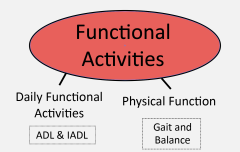Geriatrics
Clinical Skills | Functional
Functional Activities Domain

The functional activities domain within the practice of geriatric medicine involves assessing a patient's ability to perform daily activities, gait and fall risk.
- For our patients who have difficulties performing these functions, geriatricians must pay extra attention to how these issues impact their other major Domains, and vice versa.
- Can help to diagnose medical problems: Parkinsonian gait, foot drop, etc.
Daily Functional Activities
This includes the patient's ADLs and IADLs.
- Download ADLs and IADLs handout
- Patients with cognitive deficits (i.e. Dementia) have difficulties performing their activities independently
- Get collateral information from family and/or caregivers on true function
- Distinguish functional decline due to medical or cognitive limitations
Physical Function: Balance, Gait and Falls Assessment
A fall resulting in bone fracture, head trauma or other injury has serious consequences in morbidity and mortality. One can use the Tinetti gait and balance assessment to determine if a patient may need one of the following:
- Outpatient Physical Therapy
- Durable medical equipment (DME)
- Skilled Nursing Facility (SNF)
- Balance: Assess a patient's ability to maintain their balance
- Download Stance handout
- To make it more challenging, ask the patient to cross their arms and close their eyes while maintaining balance
- Be sure to stand next to patient for safety
- Gait/Tinetti: Use the Tinetti gait and balance assessment, a breakdown of the components of balance and gait
- Timed get up and go (TUG) test: The TUG test assesses a patient's mobility. Longer times correspond with worse health outcomes.
- Test instructions:
- Rise from sitting position
- Walk 10 feet
- Turn around
- Return to chair and sit down
- Test instructions: